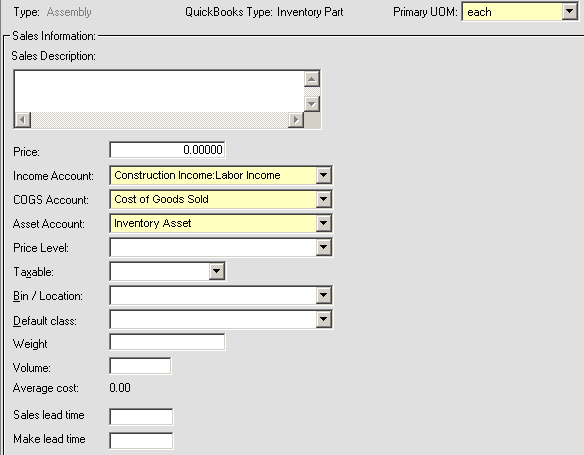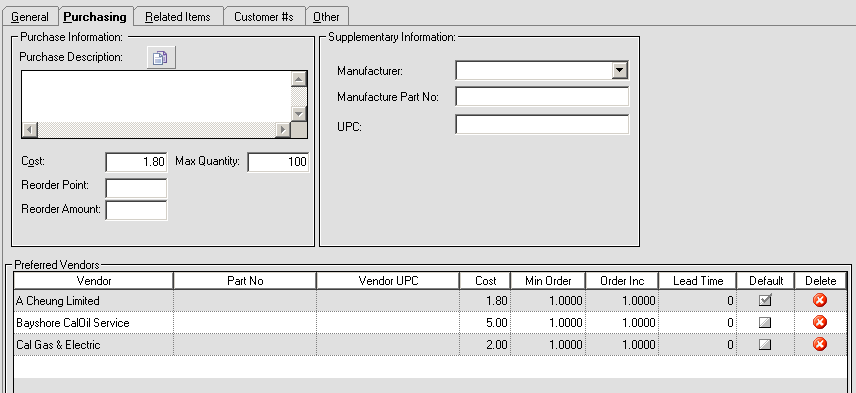Other Resources
All Orders provides rich functionality for managing you items. There are numerous considerations in creating your items such as:
Whether to use inventory or non-inventory items
Whether to use a bill or materials or kit.
Whether an item should marked as being serialized or lotted.
If you need to create items that are part of a style matrix (such as colors and sizes), the consider using the Style Manager.
Please read Item Setup which discusses some of these consideration. This topic is divided as follows:
You can bring up the New Item form from the Sales, Purchasing, Production, or Warehouse menus, by clicking its icon on the main toolbar, or by pressing Ctrl+I. Additionally, double-clicking a record on the Item List will also bring up this form, and its fields will be populated with that record's information.

To create a new Item, first you must choose an Item Group from the Group drop-down list. It's important to select correctly, as this choice will govern which other fields are available for your use.
Then provide a name (or number). You can also use the NextSeq# button if your Item names are partially numeric and All Orders will display the next number in sequence. If this Item is a sub-item of a pre-existing Item, check Sub-item of, and choose the Item from the corresponding drop-down list. Note, you can also use the Copy button to copy the entire contents of an existing Item into the new Item.
If you're at (or nearing) the limit of entities you can store within QuickBooks, All Orders provides a mechanism by which you can continue to add more Items. You can do this by selecting a 'Proxy' Item. When you choose a proxy, the new Item will show up in QuickBooks as the proxy Item rather than as a new Item. This helps keep the quantity of entities in QuickBooks to a manageable size. To select a proxy for your new Item, simply check Has Proxy, and then select the proxy Item from the drop-down list.
The rest of the dialog is separated into tabs. Which tabs you have (as well as the contents of those tabs) will depend on the type of Item Group you selected. Let us therefore look at each of these in general terms:
General (all types). This is where you enter general descriptive information about the Item, set its weight and volume (for parts), and specify financial information such as price, accounts, price level, and whether the Item is taxable. See General Tab for a more detailed explanation.
Purchasing (all types except Job & Kit). Here you can detail purchase information, such as cost, reorder point, reorder amount, and maximum quantity. You can add information about the Manufacturer, and even select preferred Vendors from whom you routinely procure the Item. See Purchasing Tab for a more detailed explanation.
Bill
of Materials (Assembly & Job types only). This field shows
a detailed list of components that make up the Item. To create a BOM for
a particular Item, click the Edit
Bill of Materials... button from this tab, where you'll be
able to specify the steps and components that result in the Item's production.
Kit/Config
(Assembly, Job, & Kit types).
If the Item is a kit, you can use this dialogue to specify the different
components that comprise it. If the Item is an Assembly or Job, you can
use the tab to list out those Items that are optional or not part of the
assembly. More
on kits and configurations...
Related Items (all types). On this tab, you can choose Items in your inventory that are somehow related to the current item. Just pick a related item from the drop-down list, enter a description, and choose a relation. Relations come in two flavors. Either the Item is a Replacement, that is, something that can substitute for the current Item if it's out of stock, or it is an Up Sell, which can be accessories, related services, or any other Item that somehow augments the main Item.
Customer #s (all types). If a certain Customer is required to refer to one of your Items by a particular part number, you can record this information here. Besides being available for reference purposes and reports, the customer #s can also be scanned to add the item to a document and you can also limit items that can be sold to customers to require a customer # being on file. You can turn this on under the Sales Order Preferences.
Other (all types). What you see here will depend on the Item Group type, but can include UOM conversions, linked files, and whether the Item in question has lots or serial numbers. See Item Images and documents for a more detailed explanation on adding images and document to the item.
In addition to the standard buttons, the New Item form offers two exclusive buttons on its toolbar:

NextSeq# is designed to facilitate the creation of new Items. When pressed, the system will check for the name and current group of the Item most recently entered. If there are any numerical values at the end of the name, it will auto-increment and place a newly generated name into the Item name field.

Type: This is the All Orders item type.
Quickbooks type: This is the Quickbooks item type. Note that while this will generally be the same as the All Orders time there are times when it will be different. For example, if a new assembly is created in All Orders there are many additional aspects to the assembly that All Orders maintains which Quickbooks does not. For simplicities sake All Order will generate the item as a regular inventory part in Quickbooks to avoid the complexities of keeping the assembly information out of Quickbooks since it is unnecessary for it to be there.
Primary UOM: The unit of measure that the item is stocked in.
Sales Description: The description of the item that will be shown on customer facing documents.
Price: The standard price that the item sells for.
Income/COGS/Asset/Expense Accounts: The Quickbooks accounts that will be applies to the items.
Price Level: If you have any Volume Discount type Price Levels setup that you want applied to the item you can set it here.
Taxable: Assign a tax code specifying whether the item is taxable or not.
Bin/Location: This is the default bin/location where and item will be received into when it is added to a document. It can be manually changed on each individual transaction.
Default Class: The default class that will be applied to the item for Quickbooks class tracking purposes.
Weight: The weight of the item.
Volume: The volume of the item.
Average Cost: The current Average Cost for the item as calculated by Quickbooks.
Sales Lead Time: The expected time needed for selling the item.
Make Lead Time: The expected time needed for making the item.

Purchase Description: The description of the item that will be shown on vendor facing documents. Includes a handy copy button to quickly copy in the sales description if they are the same.
Cost: The standard cost of the item. When the item is being purchased and no cost can be found with preferred vendor (see below) this is the default cost at which the item will be purchased at. It can be manually changed on each individual transaction.
Reorder Point: If stock levels fall below the quantity entered here, the item will be flagged as needing to be reordered by the Reorder Analysis. Reorder Points can be updated in bulk based on past usage by using the Recalculate Reorder Points Screen.
Reorder Amount: When reordering items through the Reorder Analysis you can specify how much you want to reorder based on a few different criteria. The Reorder Amount quantity is one of the options for the quantity you want to reorder each time you place an order with your vendor for the item.
Max Quantity: The Max Quantity is the most quantity that should ever be in stock for an item at any given time. When reordering an item through the Reorder Analysis, if the amount that is going to be placed on order will push the total quantity in stock over the Max Quantity, the amount placed on the order will be reduced so as not to go over the Max Quantity.
Manufacturer: The manufacturer of the item. You can manage your list of available manufacturer through the Manufacturer Profile List screen.
Manufacturer Part No: The manufacturer's part #. Once entered, the manufacturer's part # of any item can be scanned onto any document to add the item to the document.
UPC: The UPC of the item. Once entered, the UPC of any item can be scanned onto any document to add the item to the document.
As many businesses purchase products from multiple vendors, All Orders allows you to have multiple vendors per Item. Each vendor has their own part number, cost, lead time and other pertinent information. To add a vendor click the Purchasing Tab then click in an empty line in the Preferred Vendors grid. You will see a drop down of your active vendors which you can select. You can only enter each vendor once per item. After selecting the vendor enter the rest of the information as follows:
Part No: This is what your vendor call your item. You can print this on purchase orders to provide better information to your supplier. You can also scan this number into a PO or Receiver and it will automatically bring up your part number.
Vendor UPC: If your vendor has a UPC which differs from the UPC you use, enter it here.
Cost: This is the cost used for the item on a purchase order when the purchasing from the particular vendor. It is important to note that this cost should be entered in the VENDORS' currency.
Min. Order: This is the minimum order amount on purchase orders. All Orders will automatically correct purchase order quantities to conform with vendor minimum order requirements.
Order Inc.: This is the order increment. All Orders will automatically correct purchase order quantities to conform with vendor order increment requirements.
Lead Time: This is number of days it takes your vendor to deliver from the order date. All Orders used the lead time in conjunction with the order date to determine the 'due date' when creating purchase orders from the reorder analysis.
Default: Indicates the default vendor. You may already have an entry imported from QuickBooks. To change the default vendor, simply click the check box for alternate vendor.
Please review working with vendors to see how the above information is used in All Orders.
In All Orders you can store images and documents of any type in All orders, even web images.
Click the 'Other Tab' and you will see two buttons on the bottom. Click 'Add'.
You then be prompted to select whether the file is a local or web file. If its a local file, simply click OK and you will be prompted for the location of the file. Ifs its a web resource, enter the URL / web address of the image (e.g. http://www.numbercruncher.com/images/logo.gif) then click OK.
You can add an unlimited number of files.